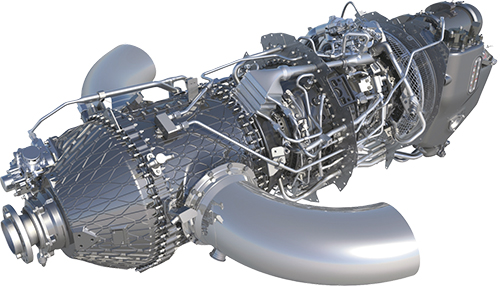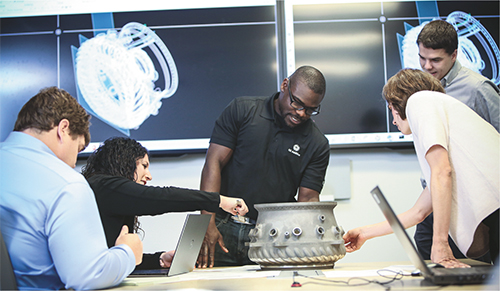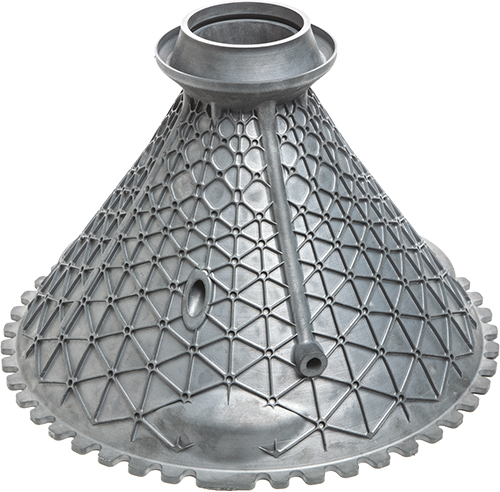Gordon Follin, GE’s engineering manager for the ATP program, singles out a part exemplifying the holistic nature of the project: the exhaust case. “Serving as an aerodynamic flow pass, allowing air to exit the engine with minimal pressure loss, the exhaust case must be designed with enough strength to withstand the pressure of the airflow traveling through the engine,” he explains.
“If we had designed the ATP exhaust case using subtractive-manufacturing techniques, we would have had to design the entire case with a thickness dictated by the weakest point, which adds unnecessary weight. By utilizing additive, we designed significantly more complex aerodynamic shapes and then added features for structural stiffness. The exhaust case has a very thin liner, which is the aerodynamic shape, and then we printed external spars on the case that provide the required stiffness strength where it’s needed to improve aerodynamics, while lowering the weight of the case.” Additive ATP components made from titanium, cobalt chromium and nickel-based alloys resulted in a 5-percent weight reduction.
Lessons Learned from Nature
Many of the design lessons learned and applied during the project were inspired by nature, says Mook. In other words, biomimicry—the design and production of materials, structures and systems modeled on biological entities and processes, as defined by Oxford University Press.

|
| This advanced turbo prop (ATP) for a Cessna Denali aircraft by Textron Aviation, Wichita, KS, represents the efforts of hundreds of GE Additive engineers, 35 percent additive content and a huge parts-count reduction—from 855 subtractive-manufactured parts to just 12 additive-manufactured parts. |
“We looked for ways that nature accomplishes what it needs to do,” says Mook. “For example, we studied animals and the way they’re designed when it comes to cell structure and cell walls. It’s amazing how those structures are designed for strength where strength is needed most. We took what we learned from studying cell structures in nature, and we applied that to developing the complicated grid-like patterns found throughout the engine design.
“Biology essentially solves the stress and strain equation and always in the most efficient manner,” he continues, “moving way beyond fixed shapes and resolving shapes to fit the function. We can, and do, apply these lessons to topology optimization when it comes to parts and simulation design.”
Future Is Bright
Mook says that GE Additive uses a combination of proprietary “homegrown” software. Its recent acquisition of Belgium-based GeonX, provider of simulation software, will enable GE Additive to continue development of aerospace applications for metal AM, as well as medical, power generation and automotive.
The ATP project follows on the heels of the company’s successful development and production of complex additive fuel-nozzle interiors for LEAP jet engines by CFM International, a 50/50 joint company of GE and Safran Aircraft Engines of France.

|
| GE Additive engineers at work on the advanced-turbo-prop project. Innovation Leader Josh Mook says GE is “unlocking the mindsets of engineers” when it comes to embracing additive manufacturing. |
Last November, more than 11,000 LEAP engines were on order, and it was reported that GE would produce about 6000 of the fuel-nozzle injectors in 2016, growing to 12,000 in 2017 and 35,000 annually by 2020, using more than 50 machines at its manufacturing facility in Auburn, AL. Meanwhile, the company recently announced plans to build a factory outside of Prague, Czechoslovakia, for production of the ATP engines.
Mook says that GE is taking what it has learned from its jet-nozzle and ATP successes to develop training courses to teach engineers how to design to the additive process, and that future additive efforts will involve more inhouse industrial designers. “I don’t think we understood early on the value of merging industrial design with engineering additive solutions,” says Mook. “Now the engineers are involved and regularly consult on an as-needed basis.
“What we’ve been able to do,” he continues, “is develop an ecosystem around additive design and additive manufacturing. We’ve learned a great deal and now we’re making available our methodologies and consulting expertise to other companies as part of our GE AddWorks business. Our teams of engineers, scientists and industrial designers can help jump start companies looking to pursue additive. This is a full-service program, complete with machines, materials and engineering expertise. It’s about shared successes in additive.” 3DMP
See also: GE Additive
Technologies:
 Joe Jancsurak
Joe Jancsurak










